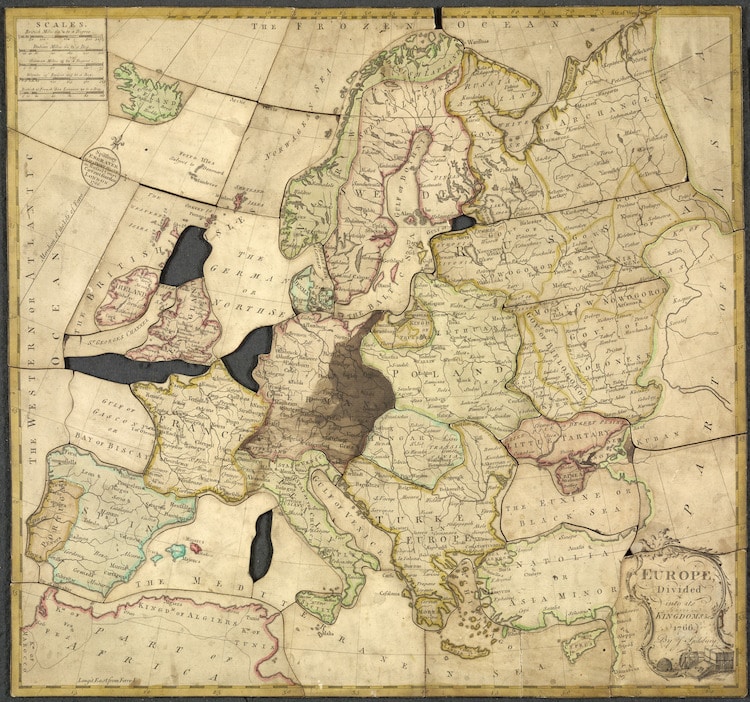Getting to Know You Puzzle Piece
Completing a jigsaw puzzle is an ideal way to relieve stress, keep your hands busy, and build something beautiful. These intricate games are made upward of hundreds and fifty-fifty thousands of unique interlocking pieces and are available in a myriad of designs and difficulty levels. Artists and creative companies are continually exploring the boundaries of jigsaws, inventing anarchistic, yet beautiful, takes on the age-old activity—like a circular 1,000 piece depiction of the Moon or a reversible 500-piece blueprint of the Guggenheim Museum.
Although puzzles are often regarded as a leisure activity, its ancestry are rooted in education and the teaching of geography. Here, we explore the history of jigsaw puzzles to see how this tiling activity has get a popular pastime for children and adults alike.
Early History of Jigsaw Puzzles

"Europe Divided Into Its Kingdoms," John Spilsbury, 1766. (Photo: Wikimedia Commons [Public Domain])
Seeing that the commencement puzzles were well-received, Spilsbury began a business and produced puzzles under eight geographical themes: the World, Europe, Asia, Africa, America, England and Wales, Ireland, and Scotland. These early puzzles were popular with affluent households, including the British Imperial family.
The Second Industrial Revolution of the 19th and 20th centuries greatly improved the puzzle-making process. Advancements in lithographic printing techniques enabled puzzle makers to transfer higher quality prints onto wooden surfaces. And instead of using hardwood (such as mahogany) to produce puzzles, manufacturers began using plywood—in which layers of thinner woods are adhered together. This immune for lighter and more than affordable material that was besides easier to cut. Additionally, the invention of foot-powered treadle saws allowed manufacturers to create more intricate interlocking pieces at a fast pace.
The proper name "jigsaw" refers to the specialized saws used to produce them, however it would not become commonplace until decades later.
Boom in Popularity
When the Great Low hit America in 1929, puzzles experienced a huge surge in popularity. Instead of producing puzzles out of forest, American companies began mass-producing puzzles out of cardboard using a new dice-cutting technique. This drastically reduced the cost of puzzles. At a time when most families could not beget more expensive recreational activities, jigsaws provided a recyclable form of amusement.
In fact, because puzzles were so cheap to make, advertisers used them as an opportunity to circulate promotional images. Other companies explored more artistic designs of fairytales, castles, ships, and nature. By the 1900s, cardboard jigsaw puzzles were the dominant product, and antiquated wooden puzzles became a rarer, high-stop item.
How They're Made Today
Now, the production of jigsaw puzzles is completely modernized and highly variable. Most manufacturers gum the desired image onto the sheet of cardboard, which is and then fed into a automobile that creates the interlocking shapes by pressing downwards with precise, steel blades. Other companies employ more than avant-garde technology such as lasers to create highly unique pieces. The strength of laser cutting also allows for a more durable cloth, such equally hardwood or acrylic, to be utilized with ease.
Due to this, unique and unconventional puzzles are emerging which explore the specific parameters of the centuries-old activity.
Amazing Jigsaw Puzzles
Jigsaw puzzles have seen a resurgence in popularity in 2020 due to the coronavirus. The global pandemic, which left the world in lockdown, gave fashion to more than at-dwelling house activities like solving the humble jigsaw puzzle. With this growing interest in the age-old pastime, designers began getting creative with the sort of puzzles people could piece together and potentially hang as an artwork. The completed piece was now almost similar a beautiful bays.
Blitheness studio turned puzzle making studio, Yelldesign, is one of the most contempo puzzle entrepreneurs to create a jigsaw that makes yous look twice. Called "The Accident," this transparent acrylic puzzle is modeled later a shattered pane of glass.
Design studio Nervous Organisation has as well been pushing the boundaries of puzzle making with their series of highly unique and extremely challenging Geode puzzles. These maze-like jigsaws are created by a computer simulation that creates natural simulations in the shape, pieces, and image.
Additionally, the record for world's largest puzzle appears to break at rapid succession. Watch the video beneath to see the completion of the earth's largest single paradigm jigsaw puzzle—featuring 42,000 pieces.
Related Articles:
20+ Jigsaw Puzzles Y'all'll Happily Spend Hours Piecing Together
Photographer Creates Jigsaw Puzzles to Reveal Subtle Differences Between Identical Twins
This Swiss Documentary Explores the Unique History of Chair Pattern
Tracing the Glistening History of Glass Making From Ancient Beads to Gimmicky Art
Source: https://mymodernmet.com/history-of-jigsaw-puzzles/
Post a Comment for "Getting to Know You Puzzle Piece"